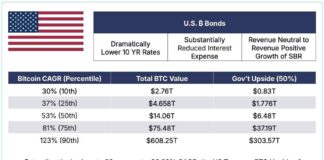|
Getting your Trinity Audio player ready...
|
ETFs, sovereign wealth funds, and asset managers are coordinating Bitcoin moves for long-term growth.
Yesterday, the price of Bitcoin surged to $103,718, reaching a peak not seen since December 2024, with many analysts pointing to the growing wave of institutional participation as the driving force behind the growth.
Institutions are operating at full capacity here, or so it seems, as corporate players and exchange-traded funds (ETFs) are accumulating more and more BTC from the open market.
“At first glance, spot ETF flows remain steady, especially during U.S. trading hours,” Bitfinex analysts reported.
“Open interest is high but not overheated, and funding is neutral — this is real demand, not a price chase fueled by leverage. Exchange balances continue to decline, and Bitcoin accumulation by long-term holders has resumed.”
This is not a speculative rally — it is a structurally justified move. As long as institutional ETF flows persist and macroeconomic conditions remain stable, any dips are likely to be short-lived and actively bought. The path of least resistance remains upward.
Some view this moment as a full-scale trend reversal.
“We are seeing coordinated flows from ETFs, sovereign wealth funds, and asset managers who increasingly view Bitcoin as a hedge against political uncertainty and a means of long-term growth.
The price movement happening right now aligns exactly with what ‘smart money’ has been preparing for all year.”
Joe Burnett, Director of Market Research at Unchained, believes that the recently announced agreement between Strive Asset Management and Asset Entities (Nasdaq: ASST) could also play a role.
“Since the Strive announcement, shares have risen by more than 700%. This highlights the growing market interest in Bitcoin-treasury companies that are converting balance sheet assets, cash flows, overvalued equity, and even leverage into Bitcoin,” Burnett said. “This is a powerful new model of capital allocation in a world of depreciating money.”
Bitcoin is becoming increasingly attractive for institutional portfolios. “Investors hate uncertainty, but on the other hand, clarity brings confidence,” explained Dave Sedacca, Chief Financial Officer at Parity Technologies.
Whether it’s Trump announcing positive changes in trade agreements or the Federal Reserve maintaining rates, these signals help stabilize market sentiment.
Combined with Bitcoin recently outperforming gold, BTC is becoming an increasingly appealing asset for institutional investors.
In summary, the current growth is fundamentally linked to the emergence of public companies modeled after Michael Saylor’s strategy, which convert their equity and even leverage into Bitcoin.
If this process continues, there will be more than enough fuel for BTC to reach $200,000+.








